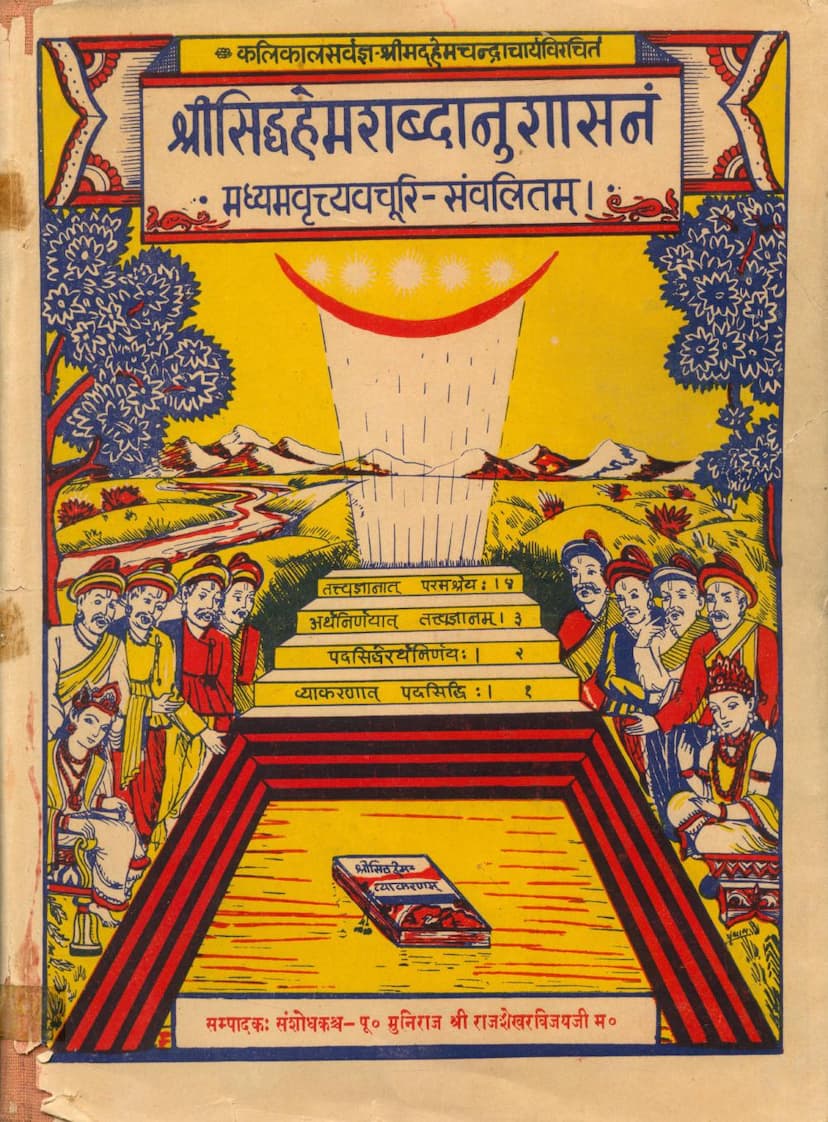Madhyam Vrutti Vachuribhyamlankrut Siddhahemshabdanushasan Part 02
Added to library: September 2, 2025

Summary
Based on the provided text, here's a summary of the Jain text "Madhyam vrutti vachuribhyamlankrut Siddhahemshabdanushasan Part 02" by Rajshekharvijay:
This book is the second part of the commentary on Hemachandracharya's "Siddhahem Shabdānushasana," a monumental work on Jain grammar. The specific commentary is titled "Madhyam Vritti" (Middle Commentary) and is further elaborated with an "Avachuri" (a secondary explanation or gloss). The text is presented in a scholarly edition, meticulously edited and researched by Muni Rajshekharvijay, a disciple of Muni Lalitshekharvijay, who in turn was a disciple of Panyas Hemantvijayji, who was a disciple of Acharya Vijaypremsurishwarji. The publication is a testament to the deep reverence and dedication of the editor to the teachings of these great Jain scholars.
Key Aspects Highlighted in the Initial Pages:
- Core Principle: The text begins by stating the fundamental Jain principle: "From true knowledge, supreme welfare is attained. True knowledge is attained from the determination of the essence. The determination of words leads to the success of understanding the essence." This establishes the importance of grammar (Shabdānushasana) as a path to spiritual liberation.
- Author and Acārya: The work is attributed to Kalikalasarvagya Shrimad Hemachandracharya, a renowned Jain scholar and reformer, celebrated for his immense contribution to Jain literature and his role in guiding King Kumarapal.
- Editorial and Publishing Information:
- Title: Madhyam vrutti vachuribhyamlankrut Siddhahemshabdanushasan Part 02 (Siddhahem Shabdānushasana with Madhyam Vritti and Avachuri, Part II) . Author of the original grammar: Kalikalasarvagya Shrimad Hemachandracharya
- Author of the commentary (Madhyam Vritti and Avachuri): Not explicitly stated for the Vritti itself in the initial pages, but the original Vritti is attributed to Hemachandracharya.
- Editor and Researcher: Muni Rajshekharvijay
- Publisher: Shree Shrutgyan Amidhara Gyanmandir, Shah Poonamchandji Gomaji Mudrita, Beda (Rajasthan)
- Publication Details: Vir Samvat 2491 / Vikram Samvat 2021 / A.D. 1965.
- Sources for Obtaining the Book: Shree Vijay Premsurishwar Gyan Mandir, Pindwara (Rajasthan) and Shree Shrutgyan Amidhara, Randheja (Gujarat).
- Dedication and Gratitude: The work is dedicated to Siddhantamahodadhi Acharya Shri Vijaypremsurishwarji Maharaj, with a heartfelt expression of gratitude for his teachings and blessings. The editor, Rajshekharvijay, humbly dedicates his efforts to his guru, acknowledging the profound impact of his spiritual guidance.
- Guru Stuti: The initial pages include a devotional hymn (Gurustuti) praising the spiritual preceptors, particularly Acharya Vijaypremsurishwarji, highlighting their virtues, wisdom, and compassionate nature.
- Detailed Table of Contents (Sūtra Viṣayānukramaṇikā): A significant portion of the provided text is a comprehensive index of the grammatical topics covered in the "Siddhahem Shabdānushasana" across its various chapters (Adhyāya) and sections (Pāda). This index lists specific grammatical concepts (e.g., formation of verbs, use of suffixes, noun declensions, verb conjugations, case usages, word formation rules) with their corresponding sutra numbers. This indicates the detailed and systematic nature of the grammar text itself.
- Editorial Note (Sampadakīya Vaktavya): Muni Rajshekharvijay shares his personal journey and challenges in undertaking this monumental editorial task. He recounts the difficulties faced with the ancient manuscript, the meticulous process of transcription, comparison with other commentaries (like Brihadvritti and Haīm Prakāś) to ensure accuracy, and his reliance on the blessings of his gurus. He emphasizes the importance of preserving and disseminating this valuable grammatical work.
- Biographies of Key Figures: Brief biographical details and timelines are provided for key Acāryas involved in the tradition, including Acārya Hemachandrasuriji, Acārya Kṣamabhadrasuriji, Panyas Shri Hemantvijayji, and Acharya Shri Vijaypremsurishwarji, highlighting their birth, diksha, and significant achievements.
- Narratives of Acārya Hemachandracharya's Life: Several pages are dedicated to recounting significant events from the life of Acārya Hemachandracharya, including his birth, his association with King Kumārapāla, his scholarly pursuits, and his groundbreaking work in composing the "Siddhahem Shabdānushasana." The text touches upon the societal and religious context of his time, emphasizing his role in promoting Jainism and ethical conduct. The emphasis on his grammatical work being a synthesis of existing traditions and his own innovations is evident.
- Explanations of Grammatical Concepts: While the bulk of the provided text is the index and editorial notes, interspersed are explanations of specific grammatical rules and examples from the "Madhyam Vritti" and "Avachuri." These sections delve into the intricacies of Sanskrit grammar as applied in the Siddhahem, covering verb conjugations (Ātmanepada), noun declensions, the use of various suffixes (likekta, ktavatu, kvanip, and others), and phonetic changes (sandhi). The commentary aims to clarify these complex rules with detailed explanations and examples.
Overall Purpose:
The "Madhyam Vritti Vachuri" on "Siddhahem Shabdānushasana" edited by Muni Rajshekharvijay is a scholarly endeavor to present a critical edition of an important Jain grammatical text. It aims to make the profound knowledge of Sanskrit grammar, as expounded by Acharya Hemachandracharya, accessible to students and scholars, thereby fostering a deeper understanding of Jain scriptures and promoting the study of this vital field of knowledge. The meticulous work of the editor underscores the value placed on preserving and disseminating the rich heritage of Jain intellectual traditions.